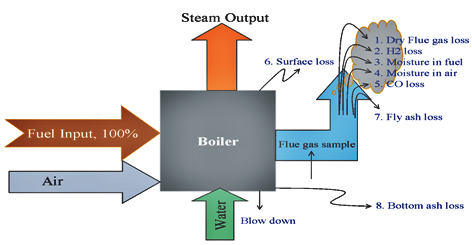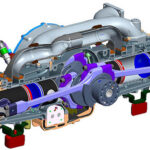A practical and simple method for calculating the efficiency of coal fired boilers is given in this article. Practical assumptions are used to simplify the otherwise elaborate calculations of the Boiler test codes.
The ASME method for Boiler Efficiency Calculation PTC 4 is elaborate and requires many input data points, measurements, and samples. With some practical assumptions, the calculations are made simple and are shown in this article.
The Losses method is used to calculate boiler efficiency. Each of the different Losses is calculated to determine the efficiency.
Data Required
For a coal fired boiler to calculate these losses we require the following data.
○ Higher Heating Value of coal on as Fired Basis HHV- kJ / kg
○ Proximate Analysis of Coal on as Fired basis which include
■ Fixed Carbon FC %
■ Volatile Matter VM %
■ Ash %
■ Moisture %
○ Hydrogen % in coal. This normally available only from an Ultimate analysis. This can be used from a past historic data for similar type of coal. The value normally is in the range of 2 – 4 %.
○
○ Gas temperature at boiler exit – Tg °C
○ Ambient Temperature – Dry bulb – Ta °C
○ Oxygen in Flue gas on a dry basis – O2 %
■ The oxygen measurement should be from a location near to the Temperature point.
■ On line Oxygen, measurements are normally on wet basis.
■ Sampled Oxygen measurements are on dry basis. In coal fired units O2 % ( dry basis)= (O2 % ( wet basis)) / 0.9
■
○ Unburnt Carbon in ash U %
■ In large coal fired plants, ash collection is in different locations. This is mainly at the Furnace bottom and the Precipitator Hoppers. The U % should be on a weighted average basis. A ratio of 85: 15 is practical between furnace bottom and precipitator ash collection.
■ U %=[U-fly ash x 85 + U-bot ash x 15] / 100
■
○ Carbon Monoxide in Flue gas – CO ppm
■ This is normally applicable in oil and gas fired units but can be applicable in Coal fired units if the combustion is very bad.
Most of these data is available readily in a power plant from online instruments and from daily analysis reports.
ASME or other codes require the ultimate analysis of Coal for finding the air and gas quantities to use in the efficiency calculations. This normally takes time. Here we make an assumption because the Stoichiometric air quantity lies within a small band for fossil fuels because of the interdependence of Carbon, Hydrogen and the Calorific value.
○ Stoichiometric Air qty
■ = 0.325 kg/ MJ for Coal Firing.
■
Controllable Losses
Losses itself can be categorised into three. First are the losses that the plant operators can control.
Following losses are in this category.
○ Loss 1. Exit gas loss or Dry gas Loss.
■ = 0.72 x [Tg – Ta ] / [21- O2]
■
○ Loss2. Unburnt Carbon loss in ash – normally for Coal fired units.
■ = U × Ash × 33810 / [100 – U ] / HHV
■
○ Loss3. Unburnt Fuel as CO – normally for oil or gas fired boilers.
■ =0.0067 x CO / [21-O2 ]
Inherent Losses
Some Losses are due to the inherent characteristics of the fuel. The operator really has no control over these losses.
○ Loss 4 – due to the Hydrogen in the coal
○ Loss 5 – due to the Moisture in the coal
■ =[9 x H + M] x [1.88 × Tg + 2500 – 4.18×Ta] / HHV
Hydrogen on combustion forms water and together with the moisture in the coal evaporates and leaves with the flue gas. The vaporisation takes away some heat from the combustion and reduces boiler efficiency. This is part of the energy conversion process.
Minor Losses
Apart from the main losses mentioned above there are many minor losses. Since these are mainly uncontrollable linked to the main losses we assume the value of these losses.
○ Loss 6 -Radiation loss.
○ Loss 7 -Heat loss in ash.
○ Loss 8 -Heat loss in coal mill rejects.
○ Loss 9 -Loss due to moisture in air
■ 1 % for coal fired boilers with ash less than 20 %.
■
■ 1.5 % for coal fired boilers with ash greater than 20 %.
Efficiency % = 100 – Sum of all Losses %
The Boiler engineer should really worry about category one. This is what the operator can adjust and reduce.


